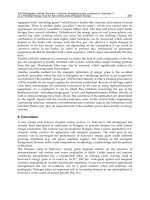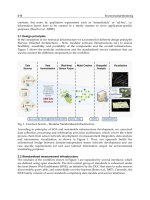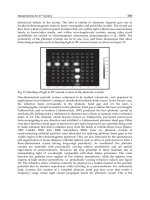Torque Control Part 16 doc
Bạn đang xem bản rút gọn của tài liệu. Xem và tải ngay bản đầy đủ của tài liệu tại đây (243.75 KB, 4 trang )
Torque Control
290
6. Future trends
In this chapter, by using the torque control, a closed-loop sensorless speed drive system has
been implemented. The proposed system can be operated from 30 r/min to 2000 r/min with
satisfactory performance. Unfortunately, the proposed system cannot be operated from
standstill to 30 r/min. As a result, it is necessary in the future to continuously improve the
controller design, hardware design, and software design to reduce the torque pulsations and
then provide better performance in low-speed operating range. In addition, it is another aim
to realize a closed-loop high performance position control system by using a torque control
method.
7. Conclusions
In this chapter, two different adaptive controllers have been proposed for a synchronous
reluctance motor drive system. The parameters of the controllers are on-line tuned. The
adaptive backstepping controller has simple control algorithm. It is more easily
implemented than the model reference adaptive controller is. On the other hand, the model
reference adaptive controller performs better in transient responses and steady-state
characteristics. A digital signal process is used to execute the control algorithm. As a result,
the hardware circuit is very simple. The implemented system shows good transient
responses, load disturbance responses, and tracking ability in triangular and sinusoidal
commands. This paper provides a new direction in the application of adaptive controller
design for a synchronous reluctance motor drive system.
8. References
[1] Park, J. M., Kim, S., Hong, J. P., and Lee, J. H.: ‘Rotor design on torque ripple reduction
for a synchronous reluctance motor with concentrated winding using response
surface methodology’, IEEE Trans. Magnet., vol. 42, no. 10, pp. 3479-3481, 2006.
[2] G. Sturtzer, D. Flieller, and J. P. Louis, “Mathematical and experi- mental method to
obtain the inverse modeling of nonsinusoidal and saturated synchronous
reluctance motors,” IEEE Trans. Energy Conversion, vol. 18, no. 4, pp. 494-500, Dec.
2003.
[3] Hofmann, H. F., Sanders, S. R., and Antably, A.: ‘Stator-flux-oriented vector control of
synchronous reluctance machines with maximized efficiency’, IEEE Trans. Ind.
Electron., vol. 51, no. 5, pp. 1066-1072, 2004.
[4] M. T. Lin, and T. H. Liu, “Sensorless synchronous reluctance drive with standstill
starting,” IEEE Aerosp. Electron. Syst. Mag., vol. 36, no. 4, pp. 1232-1241, Oct. 2000.
[5] S. Ichikawa, A. Iwata, M. Tomitat, S. Doki, and S. Okuma, “Sensorless control of
synchronous reluctance motors using an on-line parameter identification method
taking into account magnetic saturation,” IEEE PESC ’04, pp. 3311-3316, June 2004.
[6] L. Xu, X. Xu, T. A. Lipo, and D. W. Novotny, “Vector control of a synchronous reluctance
motor including saturation and iron loss,” IEEE Trans. Ind. Appl., vol. 27, no. 5, pp.
977-985, Sept./Oct. 1991.
[7] S. Morimoto, M. Sanada, and Y. Takeda, “High-performance current -sensorless drive for
PMSM and SynRM with only low-resolution position sensor,” IEEE Trans. Ind.
Appl., vol. 39, no. 3, pp. 792-801, May/June 2003.
Controller Design for Synchronous Reluctance
Motor Drive Systems with Direct Torque Control
291
[8] C. G. Chen, T. H. Liu, M. T. Lin, and C. A. Tai, “Position control of a sensorless
synchronous reluctance motor,” IEEE Trans. Ind. Appl., vol. 51, no. 1, pp. 15-25,
Feb. 2004.
[9] M. G. Jovanovic, R. E. Betz, and D. Platt, “Sensorless vector controller for a synchronous
reluctance motor,” IEEE Trans. Ind. Appl., vol. 34, no. 2, pp. 346-354, Mar./Apr.
1998.
[10] S. Ichikawa, M. Tomitat, S. Doki, and S. Okuma, “Sensorless control of synchronous
reluctance motors based on an extended EMF model and initial position
estimation,” IEEE IECON ’03, pp. 2150-2155, Nov. 2003.
[11] J. I. Ha, S. J. Kang, and S. K. Sul, “Position controlled synchronous reluctance motor
without rotational transducer,” IEEE Trans. Ind. Appl., vol. 35, no. 6, pp. 1393-1398,
Nov./Dec. 1999.
[12] Y. Q. Xiang, and S. A. Nasar, “A fully digital control strategy for synchronous
reluctance motor servo drives,” IEEE Trans. Ind. Appl., vol 33, no. 3, pp. 705-713,
May/June 1997.
[13] D. Telford, M. W. Dunnigan, and B. W. Williams, “A novel torque-ripple reduction
strategy for direct torque control,” IEEE Trans. Ind. Electron., vol. 48, no. 4, pp. 867-
870, Aug. 2001.
[14] J. H. Lee, C. G. Kim, and M. J. Youn, “A dead-beat type digital controller for the direct
torque control of an induction motor,” IEEE Trans. Power Electron., vol. 17, no. 5,
pp. 739-746, Sep. 2002.
[15] J. Beerten, J. Verveckken, and J. Driesen, “Predictive direct torque control for flux and
torque ripple reduction,” IEEE Trans. Ind. Electron., vol. 57, no. 1, pp. 404-412, Jan.
2010.
[16] Consoli, A., Cavallars, C., Scarcella, G., and Testa, A.: ‘Sensorless torque control of
synchronous motor drives,” IEEE Trans. Pow. Electron., Vol. 15, no. 1, pp. 28-35,
2000.
[17] D. A. Staton, T. J. E. Miller, and S. E. Wood, “Maximising the saliency ratio of the
synchronous reluctance motor,” IEE Proc. Electr. Power Appl., vol. 140, no. 4, pp.
249-259, July 1993.
[18] A. Vagati, A. Canova, M. Chiampi, M. Pastorelli, and M. Repetto, “Design refinement of
synchronous reluctance motors through finite-element analysis,” IEEE Trans. Ind.
Electron., vol. 36, no. 4, pp. 1094-1102, July/Aug. 2000.
[19] K. Uezato, T. Senjyu, and Y. Tomori, “Modeling and vector control of synchronous
reluctance motors including stator iron loss,” IEEE Trans. Ind. Electron., vol. 30, no.
4, pp. 971-976, July/Aug. 1994.
[20] G. Stumberger, B. Stumberger, and D. Dolinar, “Identification of linear synchronous
reluctance motor parameters,” IEEE Trans. Ind. Appl., vol. 40, no. 5, pp. 1317-1324,
Sept./Oct. 2004.
[21] H. K. Chiang and C. H. Tseng, “Integral variable structure controller with grey
prediction for synchronous reluctance motor drive,” IEE Proc. Electr. Power Appl.,
vol. 151, no. 3, pp. 349-358, May 2004.
[22] C. H. Lin, “Adaptive recurrent fuzzy neural network control for synchronous reluctance
motor servo drive,” IEE Proc. Electr. Power Appl., vol. 151, no. 6, pp. 711-724, Nov.
2004.
Torque Control
292
[23] S. J. Kang, J. M. Kim, and S. K. Sul, “Position sensorless control of synchronous
reluctance motor using high frequency current injection,” IEEE Trans. Energy
Conversion, vol. 14, no. 4, pp. 1271-1275, Dec. 1999.
[24] R. Shi, and H. A. Toliyat, “Vector control of five-phase synchronous reluctance motor
with space vector pulse width modulation (SVPWM) for minimum switching
losses,” IEEE APEC ’02, pp. 57-63, Mar. 2002.
[25] Y. Gao and K. T. Chau, “Hopf bifurcation and chaos in synchronous reluctance motor
drives,” IEEE Trans. Energy Conversion, vol. 19, no. 2, pp. 296-302, June 2004.
[26] N. Bianchi, S. Bolognani, D. Bon, and M. D. Pre, “Torque harmonic compensation in a
synchronous reluctance motor,” IEEE Trans. Energy Conversion, vol. 23, no. 2, pp.
466-473, June 2008.
[27] A. Iqbal, “Dynamic performance of a vector-controlled five-phase synchronous
reluctance motor drive: an experimental investigation,” IET Electr. Power Appl.,
vol. 2, no. 5, pp. 298-305, 2008.
[28] R. Morales-Caporal and M. Pacas, “Encoderless predictive direct torque control for
synchronous reluctance machines at very low and zero speed,” IEEE Trans. Ind.
Electron., vol. 55, no. 12, pp. 4408-4416, Dec. 2008.
[29] J. D. Park, C. Kalev, and H. F. Hofmann, “Control of high-speed solid-rotor
synchronous reluctance motor/generator for flywheel-based uninterruptible power
supplies,” IEEE Trans. Ind. Electron., vol. 55, no. 8, pp. 3038-3046, Aug. 2008.
[30] T. H. Liu, M. T. Lin, and Y. C. Yang, “Nonlinear control of a synchronous reluctance
drive system with reduced switching frequency,” IEE Electr. Power Appl., vol. 153,
no. 1, pp. 47-56, Jan. 2006.
[31] S. Ichikawa, M. Tomita, S. Doki, and S. Okuma, “Sensorless control of synchronous
reluctance motors based on extended EMF models considering magnetic saturation
with online parameter identification,” IEEE Trans. Ind. Appl., vol. 42, no. 5, pp.
1264-1274, Sep./Oct. 2006.
[32] Kristic, M., Kanellakopoulos, I., and Kokotovic, P. V. : ‘Nonlinear and Adaptive Control
Design, ( New York: John Wiley and Sons Inc, 1995).
[33] Narendra, K. S. and Annaswamy, A. M. : Stable Adaptive Systems, (New Jersey:
Prentice-Hall, 1989).
[34] Tao, G.: Adaptive Control Design and Analysis, (New Jersey: Wiley-Interscience, 2003).









